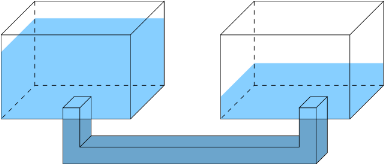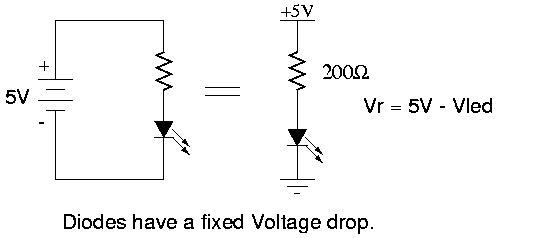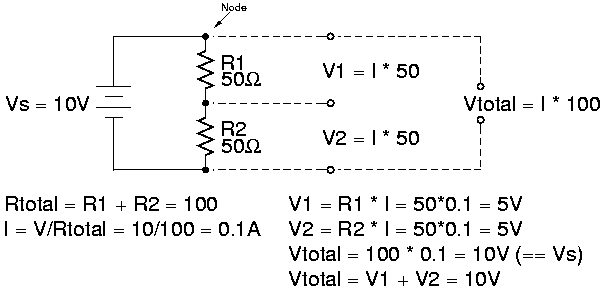Introduction to Electronics
Contents
Electrical Circuit
An interconnection of electrical elements that contains a closed loop is an electrical circuit. The closed loop allows electrons to flow through the electrical elements. We now explain how to analyze simple electrical circuits in terms of voltage, current, and resistance.
Current, Voltage, Resistance
Current describes the quantity of electrons passing through a point in a circuit at a given instant in time. Current is measured in Amperes (Amps, A).
Voltage describes the potential difference in electrical charge between two points in an electrical circuit. Voltage (also known as electric potential) is measured in Volts (V).
Resistance (a special case of Impedance) describes the capacity of a circuit element to resist or impede the flow of electrons in the circuit. Resistance in measured in Ohms.
A common analogy may be used to relate these three quantities to water flow in pipes in place of electrons in wires. Imagine you have two water tanks connected from the bottoms by a pipe (such as the drain of a double sink). If one tank is full of water and the other one nearly empty we know intuitively that the water in the full tank will flow through the pipe into the nearly empty tank.
The water in the full tank near the drain pipe is under pressure caused by gravity acting on the water above it in the tank. The difference in pressure between the water at the bottom of the full tank and the bottom of the only slightly full tank is analogous to the voltage V between poles of a battery. Recall that voltage is always measured with respect to two distinct point in a circuit. In the case of a battery there is an excess of electrons present at the negative pole which are attracted to the electron holes at the positive pole with a potential or voltage determined by the chemical and physical properties of the battery.
Current I is analogous to the quantity of water flowing through a pipe at a given moment in time. Actually for the analogy to hold rigorously, the pipe needs to be filled with some sort of material like cotton or batting that resists the flow of water.
Q: Would the voltage change if we increased the height of the water in the full tank?
Q: What happens if we open the pipe between the two tanks and let water flow?
So what governs the flow rate I right after the pipe is opened? The diameter of the pipe. The larger the pipe the less resistance there is to the water flow (or current I). Placing a resistor in an electric circuit has the same effect as reducing the water pipe's cross-sectional area. The amount of flow I is not fixed, but given the same water pressure V (or Voltage), the smaller the constriction the less flow occurs. Increasing the water pressure can counteract the reduction in flow. You can think of a battery as a pair of tanks, one full extra electrons and one empty to which extra electrons are attracted. (does adding constrictions hold in water as for electricity?) .... Ohm's Law ...
Ohm's Law
V = IR Ohm's Law states that Voltage = Current x Resistance or V = IR. The equation can be rearranged to find any one of the three quantities given the other two.
Consider the following circuit:
The voltage in the circuit is given (10V from the battery) and the resistance is also given as the 100 ohm resistor is the only resistive element in the circuit. So we can compute the current in the circuit as: I = V/R = 10V / 100 Ohms = 0.1 Amps or 100 milli-Amps.
Kirchhoff's Voltage Law
In order to be able to analyze more complicated circuits, we need to introduce two more circuit concepts. The first is known as Kirchhoff's Voltage Law. It is usually stated as, "The sum of the voltages around any closed circuit must be zero." An important consequence is that the voltage across each branch in a circuit is the same. This explains why the voltages across the battery and across the resistor in the above circuit are the same.
Kirchhoff's Current Law
Electrical components are connected together by nodes in the total network of elements. Kirchhoff's Current Law states that the sum of the currents entering a node must equal the sum of the currents leaving a node. This law is a consequence of the conservation of charge (electrons) in electrical networks.
Button LED Example
The following circuit diagram shows the most basic LED (Light Emitting Diode) circuit:
For a red LED, Vled is often about 1.7V. Diodes are from the family of semiconductors. Unlike a resistors, diodes always have a fixed voltage drop in a circuit. A diode passes current in only one direction, a very useful property for protecting circuits from incorrect current flow. The arrow in the diode symbol points in the direction that current flows, so normally you would place a diode in your circuit with the arrow pointing to a ground. Kirchoff's Current Law implies that the current flowing throught the resistor is the same as the current flowing through the LED. Therefore, once we know the current passing through the resistor in this circuit, we also know the current passing through the LED. The brightness of an LED is proportional to the amount of current passing through it. How would you make the LED shine brighter? less brightly?
Now consider the following circuit which adds a button:
The button simply interrupts or re-connects the flow of current through the circuit lighting or extinguishing the LED in the process.
Watt's Law (P = VI)
Calculating the power dissipated by a circuit element is simple. Often much of this power is converted into heat, so by thinking about the power dissipated by circuit elements, you can make sure that they don't burn up or catch on fire! (When a musical instrument catches on fire, the way in which the performer interacts with it usually changes.)
Watt's Law states that: Power (in Watts) = Voltage (in Volts) x Current (in Amps) P = V I Combining with Ohm's law we get two other useful forms: P = V*V / R and P = I*I*R Power is a measurement of the amount of work that can be done with the circuit, such as turning a motor or lighiting a light bulb. Consider a 100Watt light bulb in your home. We know the voltage applied to the bulb is normally 110V or 220V so we can calculate the current consumed as follows: I = P/V = 100W / 110V = 0.91 Amps or I = P/V = 100W / 220V = 0.45 Amps So you can see why using a 60W light buld is more economical. Your electric company normally charges you for your usage in Killo-Watt Hours (kWh). One kWh is the amount of energy necessary to do 1000 Watts of energy for one hour - in other words to keep 10 100W light bulbs shining for one hour.
Series Circuits
Consider this slightly more complicated circuit:
When two resistors are connected in series, their combined resistance is equivalent to the sum of their individual resistances.
We can use Ohm's law to calculate the voltage drop around each of the individual resistors after calculating the voltage drop accross the total resistance.
Parallel Circuits
When two resistors are placed in parallel in a circuit, their combined resistance is equal to the product of the individual resistances divided by their sum. (Smaller total voltage for parallel in contrast to larger for series).
One again we use ohm's law to calculate the voltage across the resistors (same for both) and the current through each resistor.








